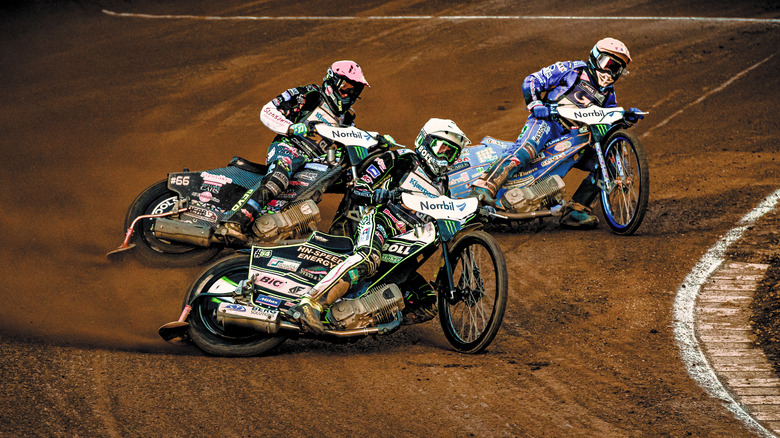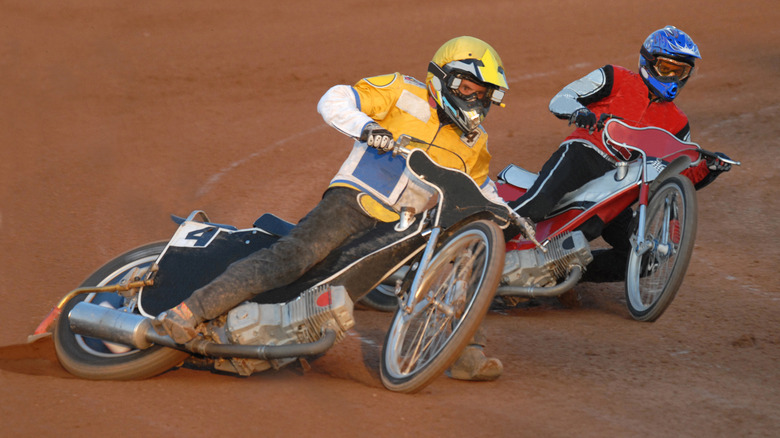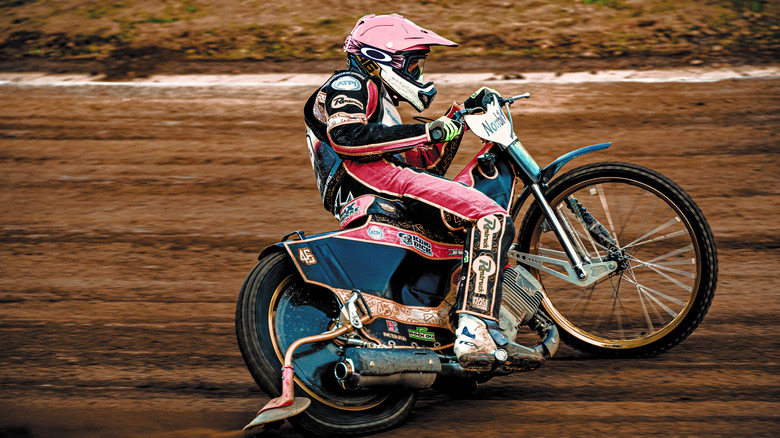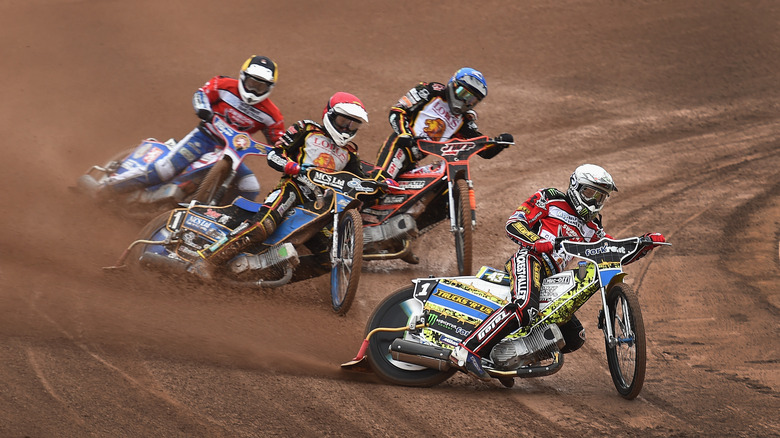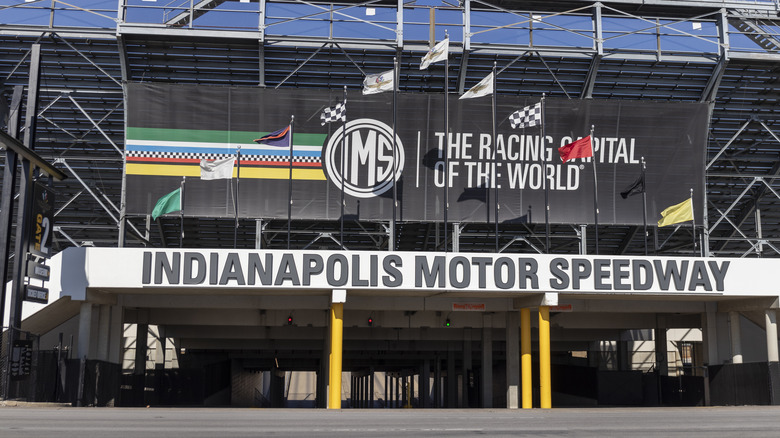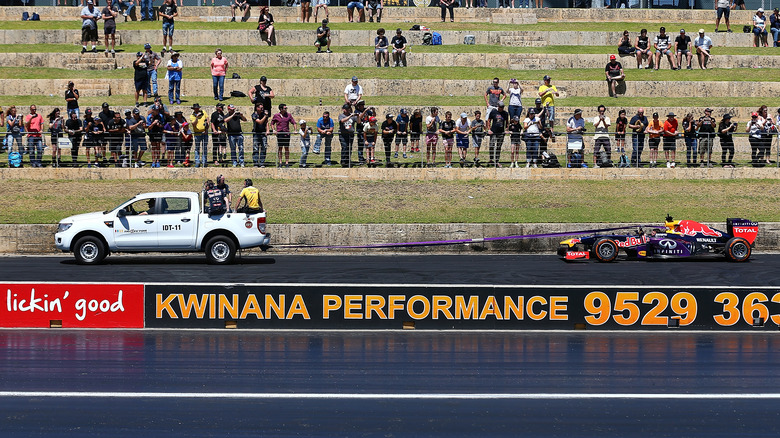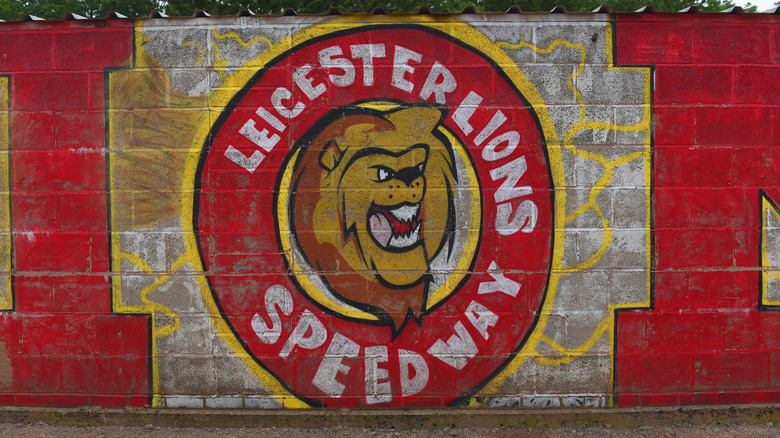What Happened To Speedway Races, Do They Still Exist?
Motor racing comes in many different exciting forms. Some are particularly unconventional: The beautiful pastiche that is the 24 Hours of Lemons, for instance, describes itself as "an endurance car racing series on dedicated road courses for $500 cars," held at venues across the U.S. such as MSR Houston and the New Hampshire Motor Speedway. The speedways of the world, however, don't always play host to events as unusual as this one. They are frequently — as the title suggests — the home of speedway racing.
A $500 four-wheeled lemon is one type of vehicle, but conventional speedway racing is a bit pickier than that. It's a thrilling motorcycle contest, and a very different prospect to an endurance race. The goal is not to cover a great distance or race for an exhaustion-inducing time, but to complete a set number of typically lightning-fast laps on a very specific type of track. Shaped like an oval, with longer perpendicular straightaways and curved turns to take on either end, there isn't a standard, defined size for the tracks. They measure between approximately 260 and 425 meters (850 and 1394.3 feet) in the UK, and play host to only four riders at a time, but the speed of the event, its point-scoring heat system, the distinct engineering of the bikes, and its evolving worldwide appeal are all factors setting speedway apart.
The sport of speedway does indeed still exist today, and first, we're going to take a closer look at the rules.
The rules of speedway
Formula One fans will be accustomed to enjoying long races (even if F1 cars are ludicrously fast). Barring unforeseeable circumstances causing a stop to the action, there's a two-hour time limit on a Grand Prix race, and the 16-mile Pescara Circuit was the longest ever track. In comparison, speedway action has a real blink-and-you'll-miss-it swiftness about it.
Motorcycle speedway is all about the points that a team manages to accrue at a given meeting. They're awarded in a straightforward fashion: From two teams of seven, two members from each team will race each heat, and only the fourth-placed rider leaves empty-handed. It's a single point for third position, two for second, and three for coming in first. There are a total of 15 heats in a given meeting, which may make the event sound rather long. With tracks such as Australia's Gillman Speedway being just 300 meters (984.2 feet) long, though, it doesn't take the bikes any time at all to complete a four-lap heat. A Speedway Grand Prix lap takes only around 15 seconds.
These rules are not hard and fast — at 2023's FIM Speedway World Cup, there were four teams with initial squads of ten riders, with five later being nominated to compete in the semi-finals — but they emphasize the blistering pace that defines speedway. It's not a motor sport for intricate racing machines, but one for bikes perfectly tailored to their purpose, uncomplicated yet versatile by means of their changeable gears via sprockets.
The anatomy of speedway bikes
When considering taking part in a motorcycle race outside of speedway, a major concern will surely be whether the bike has brakes. You might just want to give that contest a miss if not, but in a speedway race, each team member rides a very unique, and very intimidating-sounding, bike. With no brakes and a single gear, riders have a lanyard attached to their wrists that will cut the power if the rider becomes separated from their machine.
With laps being very short and the bikes powering the riders at speeds of up to approximately 80 mph on the track's straights, speedway is a sight to behold. The unconventional bikes typically have methanol engines of around 500cc, because this power source helps to keep the lighter bikes powerful, and the action faster. This need for speed also translates to the way competitors take those corners: A dramatic skid, characteristic of speedway, marks cornering as riders accelerate (the shale of the track surface helps there) to take the turn.
This is in contrast to MotoGP in particular. As Danilo Petrucci of MotoGP's Tech 3 put it (via Motorsport Magazine), "I'm nearly always on the rear brake, into and out of corners. Really the only time I don't use it is when I'm in fourth, fifth and sixth gears."
Speedway events can be dangerous for riders.
There's inherent risk in motor racing, as well as in driving generally. In February 2023, in an interview with FIM Speedway, Denmark's Hans Nielsen (an 11-time winner of the FIM Speedway World Team Cup) remembered fellow rider Erik Gundersen's crash at the 1989 World Team Cup Final, in which a collision at one of the first bends brought down Gundersen and his three competitors: "It was a terrible accident ... I could see he was having problems breathing and had swallowed his tongue ... we didn't know what condition he was going to be in, or whether he was even going to survive." The team achieved a second-place score in the final regardless, Niesen said.
Though Gundersen wouldn't compete again, injuries and accidents rarely keep a speedway star down. In April 2024, Tai Woofinden, a racer with a trio of FIM Speedway Grand Prix wins to his name, told Monster Energy, "Since 2019 I have broken the following bones: two vertebrae in my back, a shoulder blade, three hand metatarsals, a foot, tibia and femur fracture and smashed shoulder ligaments. But we get ... up and keep on keeping on." Racers' dedication to the sport despite potential dangers just speaks to the excitement of the high-speed action.
This isn't to say that speedway racers take needless risks or that stringent regulations aren't followed to try to protect them and their fans.
The speedway experience for riders
The surface of a speedway track is covered in wet shale to create the wide skidding effect, and it's regularly watered to prevent dust from being kicked into the air and forming dangerous and track-obscuring clouds. Officials such as referees, the chief pit marshal, and the clerk of the course are in attendance at official events (wearing contrasting uniforms to ensure they can be immediately recognized) to ensure regulations are followed and vehicles are inspected prior to races beginning.
Oklahoma's Thunderbird Speedway reports that its safety measures include specific zones for viewers to watch from, keeping them out of vehicles' immediate range should the worst happen. There are perimeter barricades, and quick-response medics are always on hand.
Speedway tracks and speedway races alike, however, aren't only for official competitions in the sport of speedway. The acclaimed Indianapolis Motor Speedway — at over four miles, it's significantly longer than most speedway circuits — has been the home of the Indianapolis 500 since 1911. The 100th occasion of this historic race in 2016, Forbes reports, drew a crowd of 350,000. It's probably the highest-profile race of all on a speedway track (and has been contested by all manner of curious cars), just one example of the range of activities held at the tracks.
Australia's introduction of motorcycle speedway
Brilliant ideas can strike anywhere, and MCNews reports that this happened to the Maitland Show Society's John S. Hoskins in Australia in 1923. Hoskins sought a productive outlet for bored riders he had seen near the Maitlands Showground's venue, and on December 15, 1923, he first offered the track there as a place for both riders and spectators to enjoy themselves.
It was an impromptu event, but it wouldn't be so for long. In 1927, the capital's Claremont Showground had developed into the acclaimed Claremont Speedway. That September, 15,000 people came together to watch the first night event. Claremont Speedway closed in 2000 – with events relocating to Rockingham as a result of noise complaints. This was not the end of the speedway: The Perth Motorplex (pictured here during Perth Speed Fest in December 2015), with its speedway fondly referred to as the "half kay of clay," continues to host events, offering newcomers the chance to register for Speedway online (as well as Drag Racing, Demo Derby, and Burnouts). British Speedway, meanwhile, continues to offer training, experience, and practice days for those who'd like just a taste of the high-octane action, to say nothing of the British championship and premiership leagues that are still contested today.
Speedway races, in short, continue to be held around the world, with the sport incorporating racing talents at a range of levels. In different disciplines, too: Cycle speedway on bicycles, a 70-meter dirt track race over four laps, is another take on the sport.
The state of speedway in 2024
Speedway racing on gravel or shale in open-air arenas isn't the only form of the sport. Ice speedway, in which those bikes are taken inside and raced on ice tracks, began as a novelty in the U.S. in 1975, but International Championship Events (ICE) was established two years later by speedway racer, Gary Densford. In 1982, the body introduced a universal stud to be used by competitors, helping keep their machines stable on frozen surfaces. The championship is still running today, with the FIM Ice Speedway World Championship of April 2024 held at Heerenveen's Thialf Ice Stadium and won by Martin Haarahiltunen.
In the United States, California can be argued as the home of motorcycle speedway, with the Speedway Points Series set to take place in Auburn in late May 2024.
In the UK, the latest season of the seven-team Row Motor Oil Premiership is set to conclude in late September 2024 with a two-leg grand final. High-level British speedway races continue, then, despite the sport's seemingly declining fandom in Britain (Roddy McDougall, author of "No Breaks: A Lost Season in British Speedway," dubbed it "almost Britain's left-behind sport" on the SportsContentStrategy podcast). It's in Poland, perhaps, that the sport is most popular: the Orlen FIM Warsaw Speedway GP reached 6.6 million viewers across the country, the Fédération Internationale de Motocyclisme reported in May 2022. Its fortunes may differ by region, and its vehicles not as varied as the selection that have taken part in NASCAR, but there's no doubt that speedway races continue.
